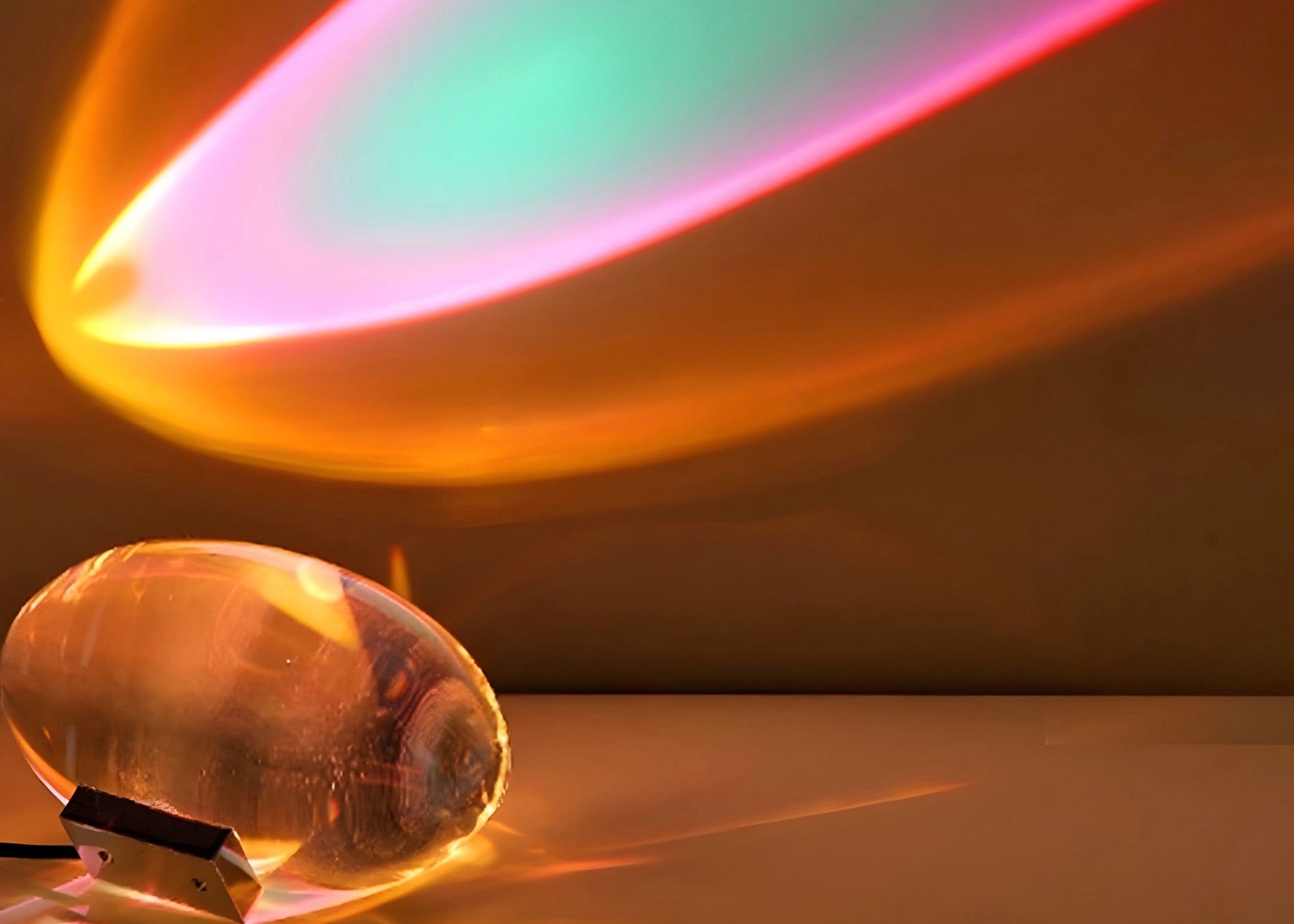


Do you know this? It's gray outside, the sky is a soup of clouds. Inside, you're sitting at your desk, the coffee is no longer working and your eyelids feel like lead. That 3 p.m. slump that sometimes starts as early as 11 a.m.? Or that general blues that covers you like a heavy blanket during the winter months? Yes, many of us know this all too well. And we often blame it on stress, too little sleep or simply a bad day.
But what if the answer is much simpler - and has to do directly with the light that surrounds us (or not)? notsurrounds us)? We are biological beings, calibrated to the natural light of the sun for thousands of years. But our modern lives often lock us in artificially lit rooms for hours on end. The result? Our inner rhythm gets out of sync, our energy dwindles and our mood sinks.
This is where a little hero comes into play that has been getting more and more attention in recent years: the daylight lamp. Sounds unspectacular at first, perhaps just another desk lamp. But don't be fooled! When used correctly, this thing can make an amazing difference to your well-being. It's like a targeted ray of sunshine at the touch of a button, just when your body needs it most.
Curious? Great! Let's find out together what these power lamps are all about. We'll dig through the jungle of lux values and Kelvin numbers, look at why our brains love this special light so much, for whom such a lamp can be a real game changer and how you can get the best out of it for yourself - without falling into typical traps. Ready for your personal bright spot?
Okay, what is the difference between a daylight lamp from the ceiling spotlight in the office or the cozy floor lamp in the living room? There are two things in particular that make the decisive difference:
The color of the light (color temperature): Imagine the light on a bright summer's day at midday - clear, bright, almost bluish-white. This is the light that makes us alert and active. This is measured in Kelvin (K). While your living room lamp may have a cozy 2700-3000 K (rather yellowish-warm), a daylight lamp with 5,500 to 6,500 Kelvin. This is the spectrum that our brain interprets as a "Hello awake!" signal.
The pure power (luminous intensity): Brightness is measured in lux (lx). On a sunny day outdoors, there can easily be 50,000 to 100,000 lux. In a typical office, it is often only a meagre 300-500 lux. A good daylight lamp manages to give you a good dose of light at a short distance (e.g. 20-30 cm) - often up to 10,000 lux. This intensity is necessary so that the light doesn't just tickle your retina, but actually triggers biological processes in your body.
Basically, the lamp simulates a bright, sunny day - and your body reacts to it. It's not hocus-pocus, it's applied biology.
It sits deep in our brain, the boss of our inner clock: the suprachiasmatic nucleus (SCN). It sounds terribly scientific, but it is actually the conductor of our personal 24-hour orchestra, the circadian rhythm. This rhythm determines when we get tired, when we wake up, when we are at our most productive, when our body temperature fluctuates and much more.
The most important baton for this conductor? Light! Especially bright light in the morning. When this light hits special receptors in our eyes, the SCN receives the signal: "Day has dawned, ramp up all systems to activity!"
Melatonin brake: The production of the sleep hormone melatonin is stopped. You become more alert.
Serotonin kick: The release of serotonin, our body's own mood enhancer, is stimulated. The mood rises.
Cortisol wake-up call: A healthy morning cortisol surge gives you energy to start the day.
The problem: if our SCN receives too few light signals or at the wrong time - which is often the case in our modern indoor lives - the whole orchestra gets mixed up. We feel tired during the day, can't sleep at night, our mood is in the basement. This is where the Day Light Lamp comes into play: It gives the SCN the necessary, powerful "light wake-up call" at the right time (in the morning!), even if the weather outside is gloomy or you're sitting in a windowless office. It helps to set your internal clock right again.
In the past, these light therapy devices were often bulky boxes. Today, most daylight lamps are slim, stylish and owe their power to LED technology. This has several advantages:
Efficient: LEDs need little power for a lot of light. Good for the environment and your electricity bill.
Durable: They light up forever, often for 20,000 hours or more. A purchase that pays off for years.
Precise: LEDs can be used to generate precisely the light spectrum required for the biological effect.
Sure: And that is crucial! Good models are UV-free. So you get the positive effects of the light without the harmful UV radiation of the real sun. Many are also flicker-freewhich is important to avoid headaches or strained eyes. Look out for these labels!
Honestly? The chances are good. But let's take a look at who particularly benefits from a daylight lampcan benefit from:
You, in the home office or office: That creeping loss of energy in the afternoon? That feeling of fighting a wall of tiredness? A lamp on your desk can help you stay focused and get through the day more alert. A real productivity booster!
You, in the fight against the winter blues (SAD): If the dark season regularly brings you down and you become listless and sad, then light therapy with a powerful daylight lamp (10,000 lux!) is a scientifically recognized and often very effective method. However, always speak to a doctor first if you suspect depression! The lamp supports but does not replace therapy.
You, as a shift worker or jetsetter: Is your rhythm constantly out of sync? Targeted use of light can help your internal clock to adapt more quickly to new waking and sleeping times.
You, as a senior citizen: As you get older, your eyes often need more light and you may not get out as often. A daylight lamp brings brightness, helps you sleep and can lift your mood.
You, as a morning grouch: The alarm clock rings, it's pitch dark... Horrible! A lamp next to your bed can make waking up much more pleasant and give you a smoother start.
You, as a learner or creative: Do you need a clear head and concentration? Bright light can help to get your gray cells going.
Simply you: Do you generally want to feel fitter, more alert and in a better mood? Then a daylight lamp can be a useful addition to your everyday life.
You've decided to give it a try? Great! So that the daylight lamp is not just a decoration, here are a few practical tips on how to use it really effectively:
Timing is everything: The morning is your friend! Ideally, use the lamp within the first hour or two of waking up. This gives your inner clock the strongest impulse. Don't use it in the late afternoon or evening - it can torpedo your sleep!
The dose makes the light: Start relaxed. 15-20 minutes is often enough at the beginning. If you feel comfortable with it, you can increase to 30 minutes (or longer, depending on the recommendation). It's not a competition - find out what works for you.
Positioning with brains: Don't stare directly into it! This is uncomfortable and unnecessary. Place the lamp slightly to the side in front of you, at about arm's length (check the instructions for the recommended distance, usually 20-50 cm). The light should reach your face and eyes while you go about your morning ritual as normal: reading the newspaper, drinking coffee, eating cereal, checking emails...
Keep at it! The key to success is regularity. Try to really schedule your light shower at the same time every day. This is the only way your body can adjust to it. It's like exercise or a healthy diet - doing it once doesn't do much, but doing it consistently makes a difference.
Listen to your body: Do you feel slightly jittery or have a headache after using it? This can happen at first. Reduce the time or increase the distance. This usually subsides quickly. If not, talk to a doctor.
Combine cleverly: The lamp is great, but it's no substitute for a walk in the fresh air. If you have the opportunity, combine the two! A walk around the block after your morning light shower - it couldn't be better.
The market is full, the promises are big. How do you recognize a daylight lampthat delivers what it promises?
Lux, lux, lux: How much power do you need? For an everyday boost, 2,500-5,000 lux is often enough. For targeted SAD therapy, 10,000 lux is mandatory (pay attention to the distance at which this value applies!).
The right "color": Look for 5,000 to 6,500 Kelvin - that's the cool white that works.
Safety check: UV-free is a must! Flicker-free is a big plus for your eyes. A CE mark should be standard, and certification as a medical product is a quality feature for therapy models.
Does it suit you? Size and design are a matter of taste, but think about where it should be placed. Compact for the desk? Large for the living room? Should it be tiltable?
Bells and whistles or useful? Do you need a timer? A dimming function? Some like it purist, others love the extras. Decide what's important to you.
What does your wallet say? Quality has its price, but there are also good devices for less than 100 euros. You often have to dig deeper into your pocket for certified therapy lamps. Perhaps read a few recent test reports or user reviews before you buy.
Phew, quite a lot of input on the subject of light, isn't it? But you see: a daylight lamp is much more than just an ordinary lamp. It is a fascinating piece of technology that is based on sound biological principles and can help you to feel more energetic, more focused and simply better.
Especially if you spend a lot of time indoors, suffer from winter fatigue or are simply looking for a natural way to boost your energy levels, the purchase of a daylight lamp is worth considering. It's an investment in your health and quality of life that can quickly pay off.
So, what are you waiting for? Give the light a chance to brighten up your everyday life - in the truest sense of the word!
When will I see the first results?
It can be quick (days), but can also take 1-2 weeks. Patience and regularity are crucial!
Are there any side effects?
Rare and usually mild (slight headache, eye irritation, jitteriness at the beginning). In case of persistent problems or previous illnesses (eyes, medication) -> ask your doctor!
Can I also use it to refresh my tan?
Definitely no! Good lamps are UV-free. You need UV light to tan (and this is not without risk).
Does the lamp replace vitamin D?
No. Vitamin D is formed in the skin under UVB radiation. As the lamps are UV-free, they do not stimulate vitamin D production. For this you need real sunlight (or food supplements).
Is more expensive always better?
Not mandatory, but with certified medical products for light therapy you often pay for tested quality and effectiveness. There are also good, cheaper models for everyday use. It's worth comparing!